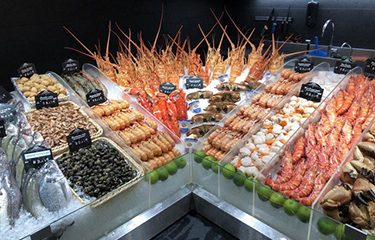US seafood price inflation declines in all areas except frozen

Overall U.S. retail seafood inflation dropped in the first quarter of 2023, which benefitted all sectors of the industry but frozen sales, according to new data shared at Elanco’s “Seafood in U.S. Retail” webinar on 2 May.
Total food and beverage inflation spiked 11.3 percent in the first quarter of this year compared versus the first quarter of 2022, but frozen seafood prices rose only 3.9 percent, fresh seafood prices were up 2.2 percent, and shelf-stable prices rose 3.7 percent, 210 Analytics Principal Anne-Marie Roerink said during the webinar, citing data from research firm Circana.
Those increases were much lower than the price hikes seen throughout 2022, according to Roerink. Still, the price hikes contributed to a 3.2 percent drop in frozen seafood sales to USD 1.86 billion (EUR 1.7 billion).
However, shelf-stable seafood sales jumped 3.8 percent in the quarter to USD 711 million (EUR 645 million), while fresh sales rose 0.2 percent to USD 1.66 million (EUR 1.5 million).
“By and large, frozen foods have seen above-average inflation, so this is not an issue isolated to seafood,” Roerink said. Seafood inflation as a whole, though, has come down tremendously over the past few months, she noted.
Frozen seafood prices increased an average of 8.3 percent over the last year, but in the most recent quarter, they were up only 3.2 percent.
Inflation in the frozen seafood segment was driven by a spike of 11.8 percent in finfish prices, led by frozen salmon, which realized inflation of 18.3 percent to USD 13.56 (EUR 12.28) per unit on average. Frozen pollock prices also jumped 16 percent in the quarter to USD 6.85 (EUR 6.20) per unit on average. Conversely, overall frozen shellfish prices declined in the quarter by 1.4 percent. Frozen crab prices plummeted 14.5 percent, while frozen shrimp prices declined 1.7 percent.
In the fresh seafood category, finfish prices also jumped 5.6 percent in the quarter, driven by cod and salmon, according to 210 Analytics. Overall shellfish prices fell 3.2 percent in the quarter.
Salmon prices rose 7.2 percent to an average of USD 10.65 (EUR 9.65) per unit on average, but the popular fish is still price competitive compared to other proteins, according to Roerink. Chicken breast prices jumped 8.2 percent in the first quarter of 2023, while pork loin prices fell 0.8 percent. While the average price for beef ribeye is up only 1.8 percent during the quarter, the average price per unit for the meat is USD 17.71 (EUR 16.06).
“When we look at the price per pound, it really is in line with several of the other, comparable center-of-plate meats,” Roerink said. "But that’s where perception comes in as well as how people react during recessions and inflation. On the meat side, we’ve seen demand for chicken increase and whole-muscle beef decrease in favor of ground beef.”
For salmon, as well as other seafood, there isn’t a “ground meat” option that shoppers can buy to still enjoy the protein at a lower per-pound cost, Roerink explained.
“[That] leaves portion size [to cut],” she said. “Working with consumers on affordability through portions and bundling with other meal items is more important now with the amount of pressure on income.”
As shoppers strive to save money on groceries, more have shifted their seafood purchases to club and warehouse stores, supercenters stores, and online, according to Roerink.
Retailers are also promoting seafood much more aggressively. In the first quarter of the year ...
Photo courtesy of 210 Analytics





Share